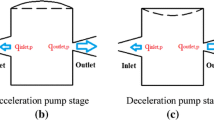Abstract
The characteristics of a double-chamber valveless parallel micropump are analysed using a one-dimensional non-linear model. The relationships between the mean volume flux, pressure difference and (measurable) characteristics of the pump are derived in a closed-form expression which are validated against the numerical solutions. These results show that when pump chambers are driven exactly out of phase, the volume flux is maximum and the variation of the pump chamber pressure is (significantly) reduced. The model predictions were tested against the experimental results of Olsson et al. (Sens Actuators A Phys 47:549–556, 1995) for both in and out of phase pumps. The mean volume flux decreases linearly with pressure rise. For both cases, the agreement is good and is an improvement over previous analytical models. The implications of these results for optimal pump design are discussed.






Similar content being viewed by others
Abbreviations
- α:
-
Characterises the shape of the deformed planar surface
- β:
-
The ratio of pipe length from the junction to the nozzles, to the external pipes
- \(\epsilon\) :
-
Dimensionless flow asymmetry
- ω:
-
Angular frequency of the actuator
- ρ:
-
Density
- τ:
-
Dimensionless time
- ζ:
-
Pressure-loss coefficient
- ΔP * :
-
Difference between the chamber pressure and mean static pressure
- \(\overline{\epsilon}\) :
-
Mean value of the dimensionless flow asymmetry
- \(\tilde{\epsilon}\) :
-
Fluctuating component of the dimensionless flow asymmetry
- \(\tilde{u}_*\) :
-
Dimensionless velocity
- A 0 :
-
Cross-sectional area of the channels
- A 1 :
-
Cross-sectional area of the throat of the diffuser/nozzle elements
- C d :
-
Relative strength of the frictional force to the dynamic force
- C p :
-
Measures of the ratio of applied pressure to the chamber pressure
- C :
-
Maximum volume displaced by the pump compared to the volume of fluid in the system
- E ϕ :
-
Dimensionless mean flow asymmetry
- f:
-
Darcy-Weisbach friction factor
- L r :
-
Wetted perimeter of the channel
- L v :
-
Valve length (diffuser/nozzle element length)
- L :
-
Length of inlet and exit channels
- P E :
-
Exit pressure
- P I :
-
Inlet pressure
- P v :
-
Water vapour pressure
- P *e :
-
Pressure after diffuser/nozzle elements
- P *i :
-
Pressure before diffuser/nozzle elements
- P C* :
-
Chamber pressure
- Q 0 :
-
Maximum volume flux
- Q :
-
Pump volume flux
- Re :
-
Reynolds number
- R :
-
Chamber radius
- V 0 :
-
Chamber volume in the absence of surface deflection
- V m :
-
Amplitude of volume oscillation
- X d :
-
Maximum deflection of actuator
- u * :
-
Velocity
References
Azarbadegan A, Eames I, Zangeneh M (2009) An integrated study of parallel valveless micropumps. In: 2nd micro and nano flows conference West London, UK, 1–2 September 2009
Cui Q, Liu C, Zha XF (2008) Simulation and optimization of a piezoelectric micropump for medical applications. Int J Adv Manuf Technol 36:516–524
Eames I, Azarbadegan A, Zangeneh M (2009) Analytical model of valveless micropumps. J Microelectromech Syst 18:878–883
Gerlach T, Wurmus H (1995) Working principle and performance of the dynamic micropump. In: Eighth IEEE international workshop on micro electro mechanical systems, MEMS ’95, 29 Jan–2 Feb 1995, vol A50 of Sens Actuators A Phys (Switzerland). Elsevier, Amsterdam, Netherlands, copyright 1996, IEE, pp 135–140
Olsson A, Stemme G, Stemme E (1995) Valve-less planar fluid pump with two pump chambers. Sens Actuators A Phys 47:549–556
Olsson A, Stemme G, Stemme E (1999) Numerical design study of the valveless diffuser pump using a lumped-mass model. J Micromech Microeng 9:34–44
Olsson A, Stemme G, Stemme E (2000) Numerical and experimental studies of flat-walled diffuser elements for valve-less micropumps. Sens Actuators A Phys A84:165–75, copyright 2000, IEE
Pan L, Ng T, Wu X, Lee H (2003) Analysis of valveless micropumps with inertial effects. J Micromech Microeng 13:390–9, copyright 2003, IEE
Stemme E, Stemme G, (1993) Valveless diffuser/nozzle-based fluid pump. Sens Actuators A Phys 39:159–167
Ullmann A (1998) Piezoelectric valve-less pump—performance enhancement analysis. Sens Actuators A Phys 69:97–105
White FM (2006) Fluid mechanics, 6th edn. McGraw-Hill Companies, New York
Acknowledgements
We gratefully acknowledge the Dorothy Hodgkin Postgraduate Award (DHPA) of the Engineering and Physical Sciences Research Council (EPSRC) of United Kingdom and Ebara Research Co. Ltd. of Japan for their financial support.
Author information
Authors and Affiliations
Corresponding author
Rights and permissions
About this article
Cite this article
Azarbadegan, A., Cortes-Quiroz, C.A., Eames, I. et al. Analysis of double-chamber parallel valveless micropumps. Microfluid Nanofluid 9, 171–180 (2010). https://doi.org/10.1007/s10404-009-0519-1
Received:
Accepted:
Published:
Issue Date:
DOI: https://doi.org/10.1007/s10404-009-0519-1




